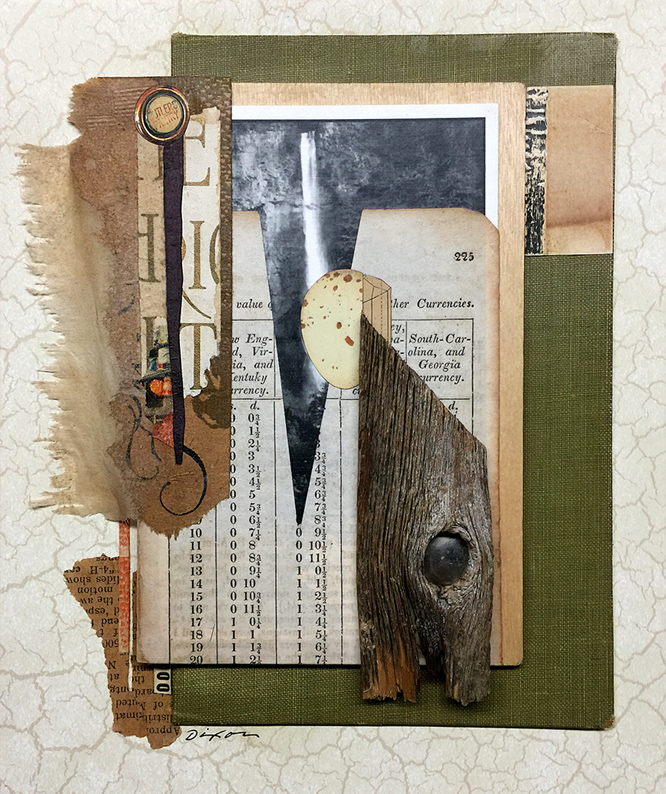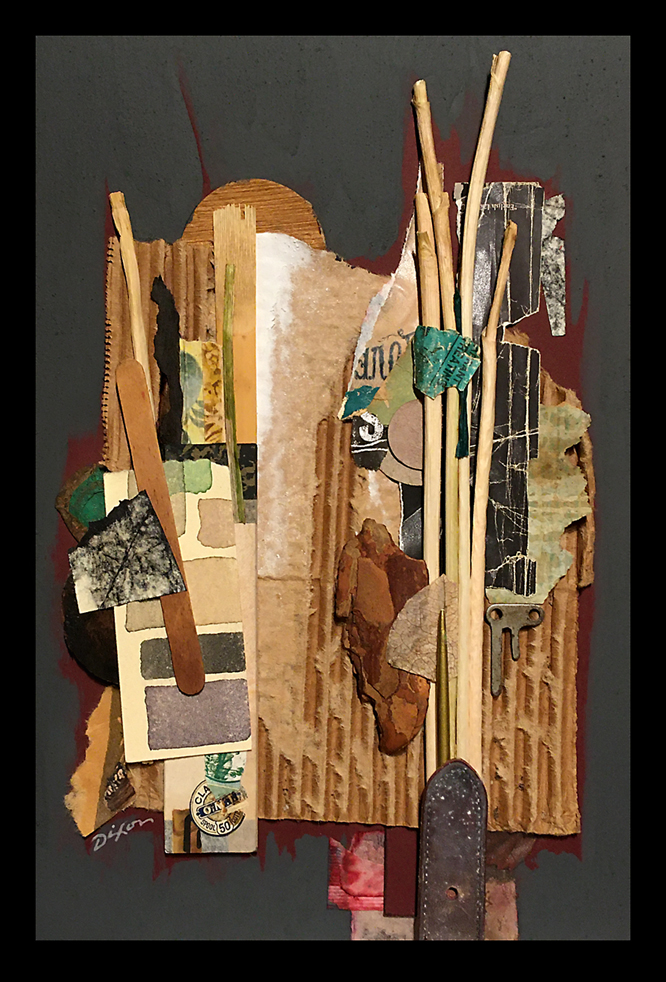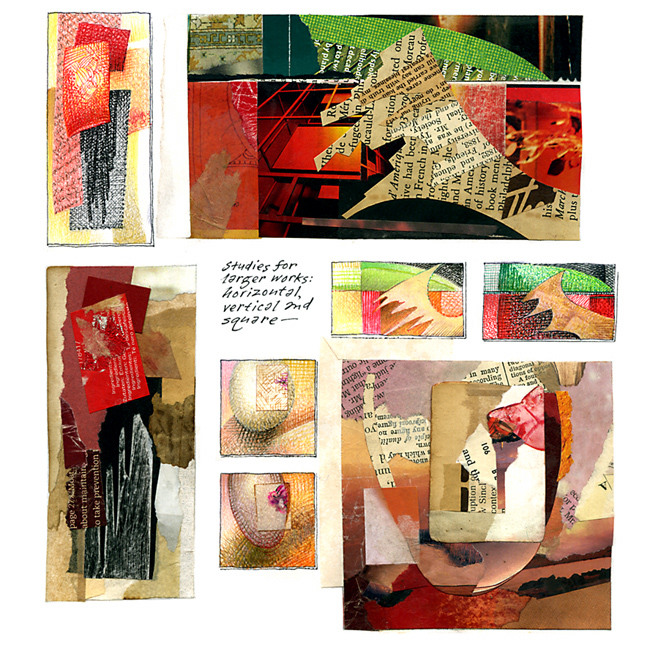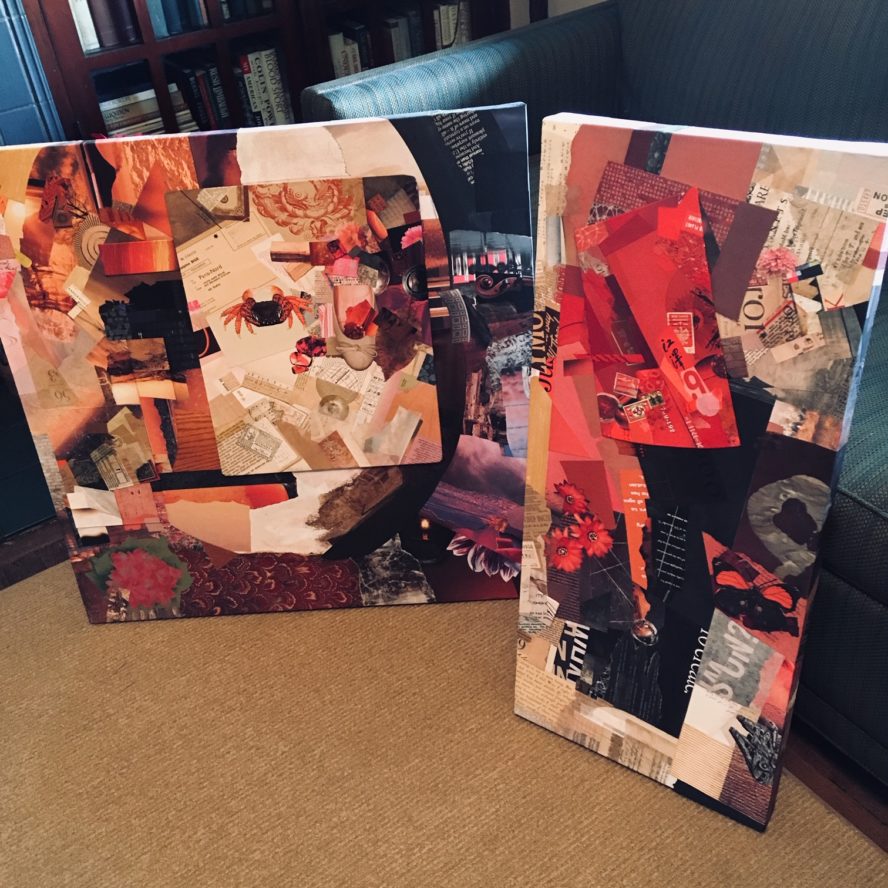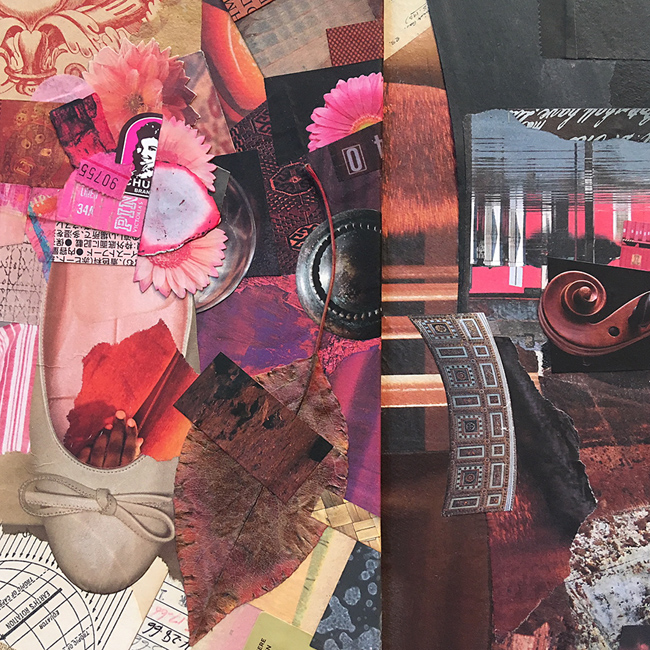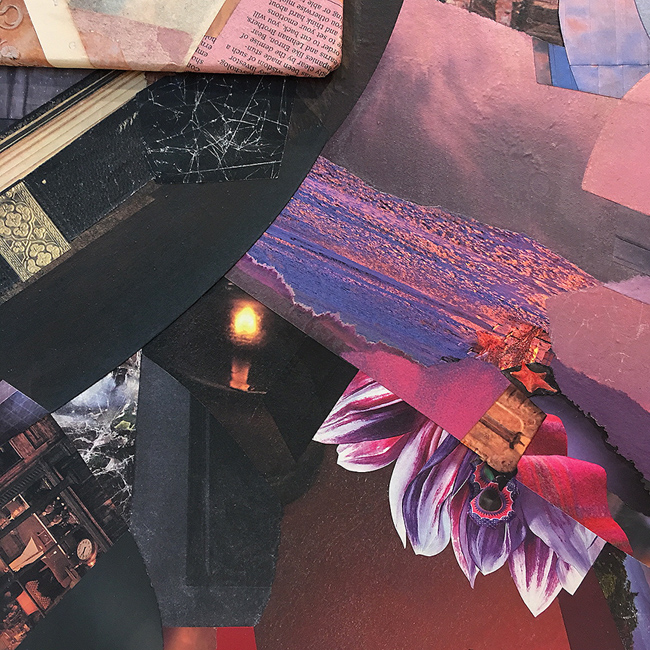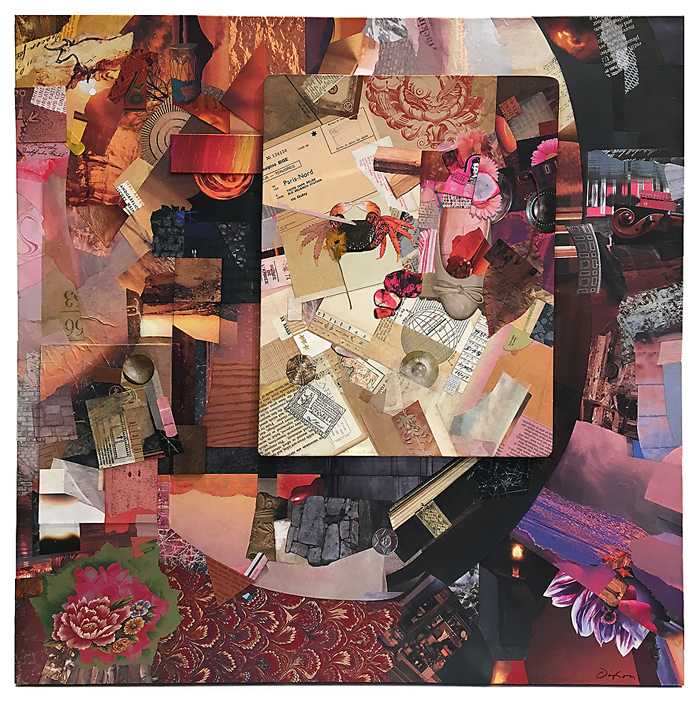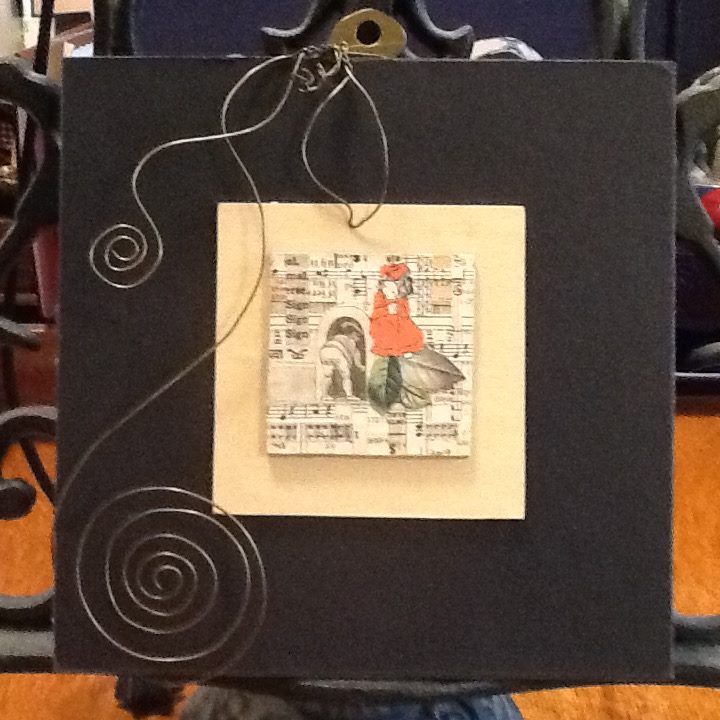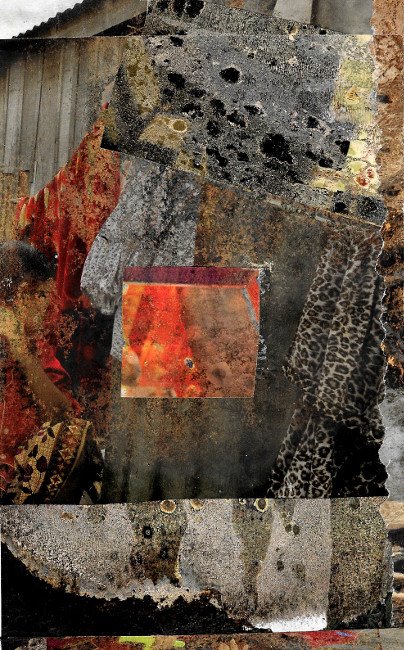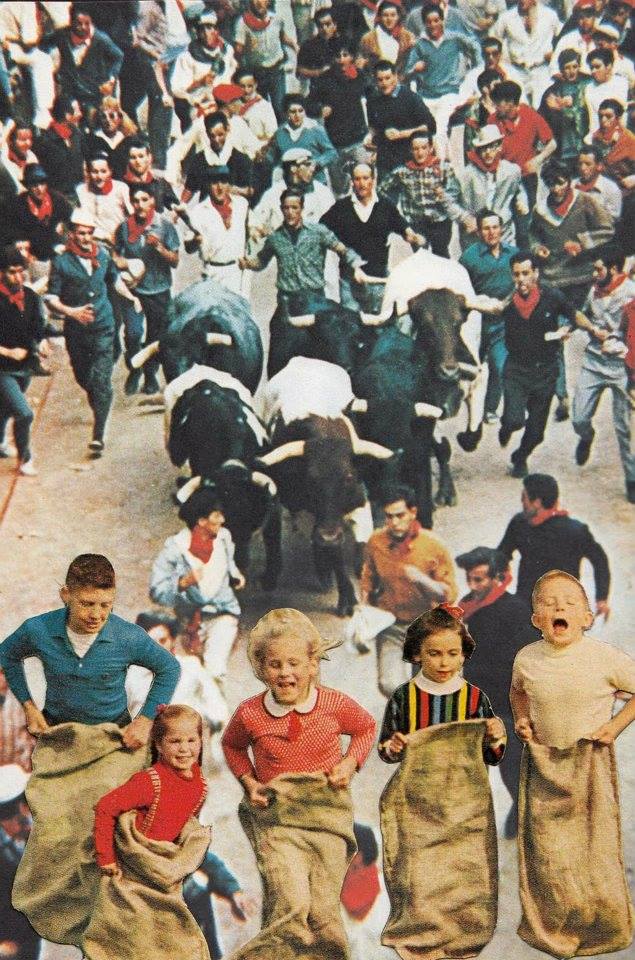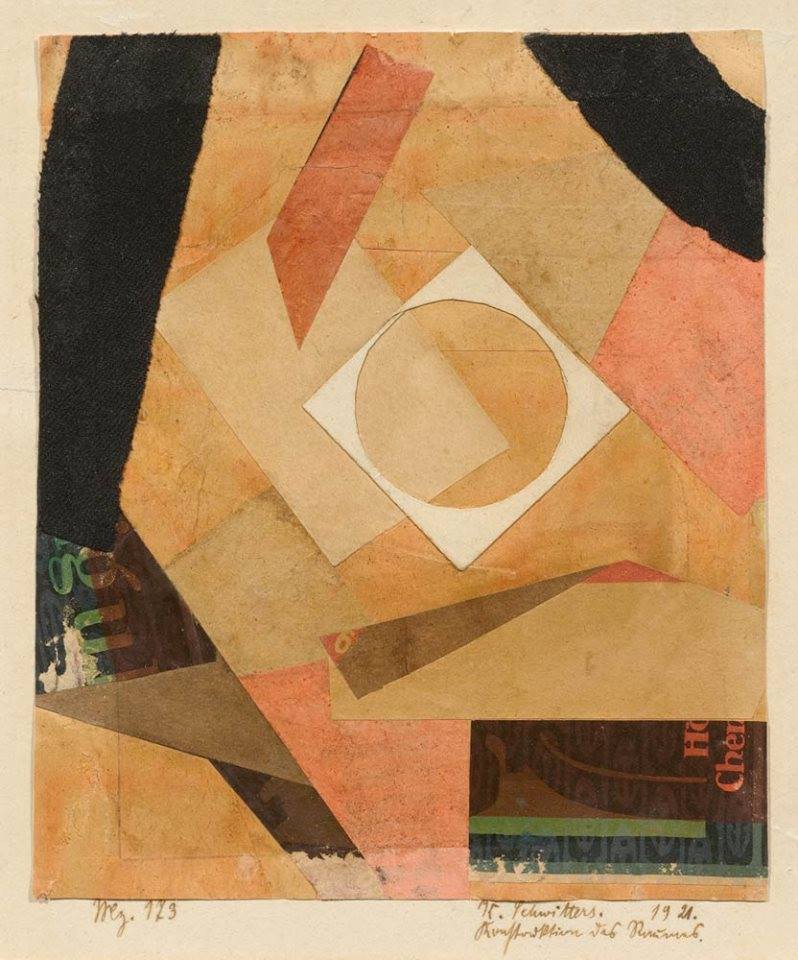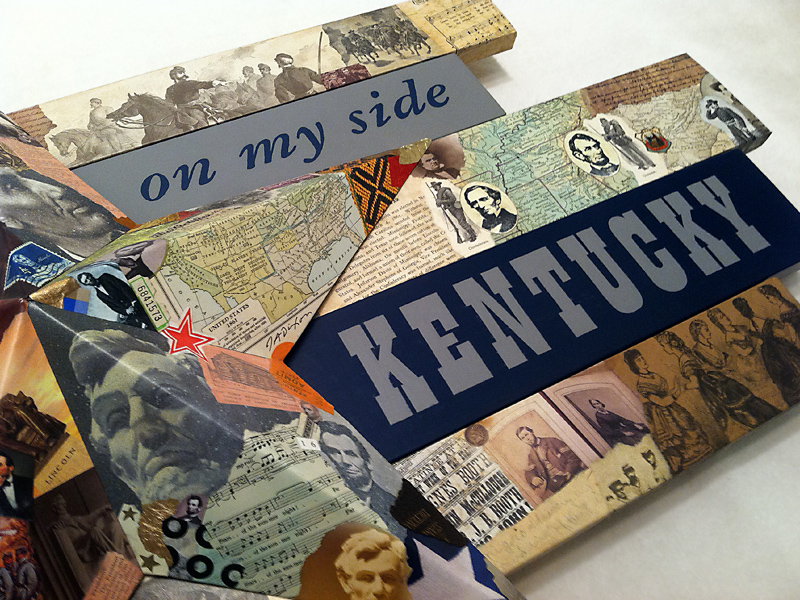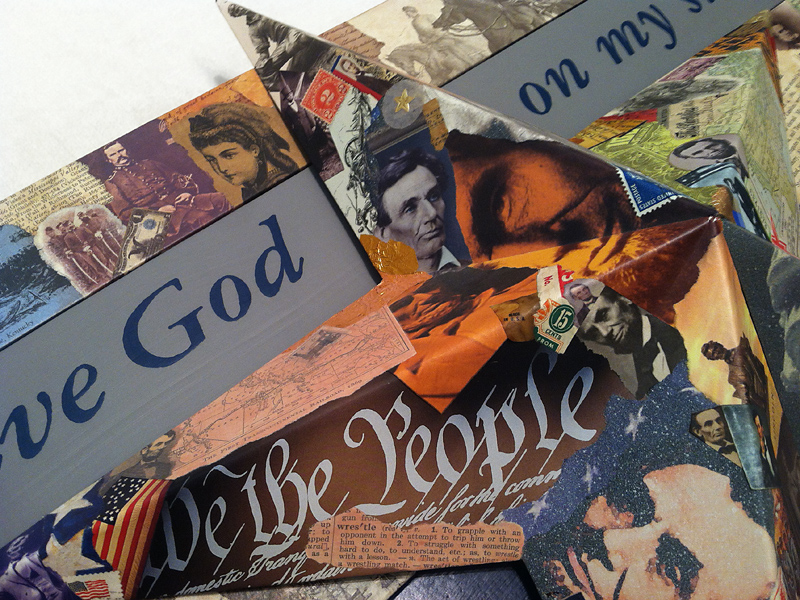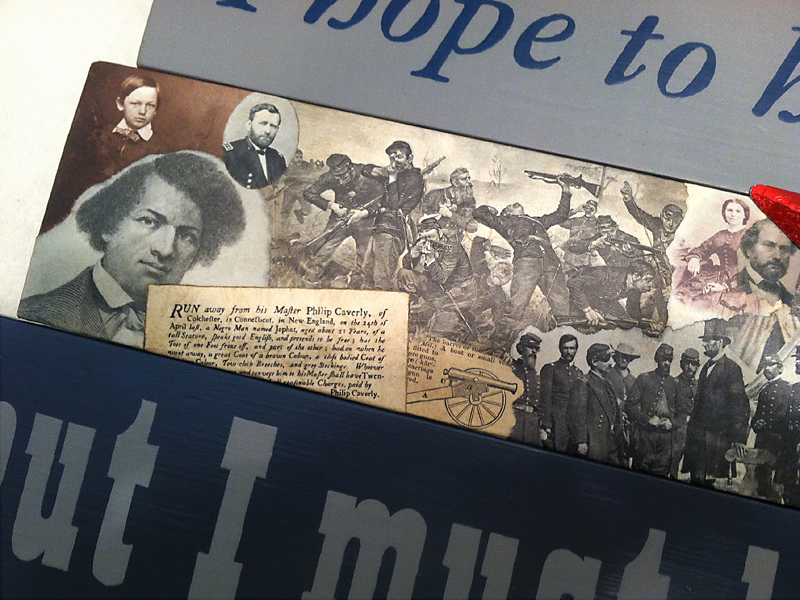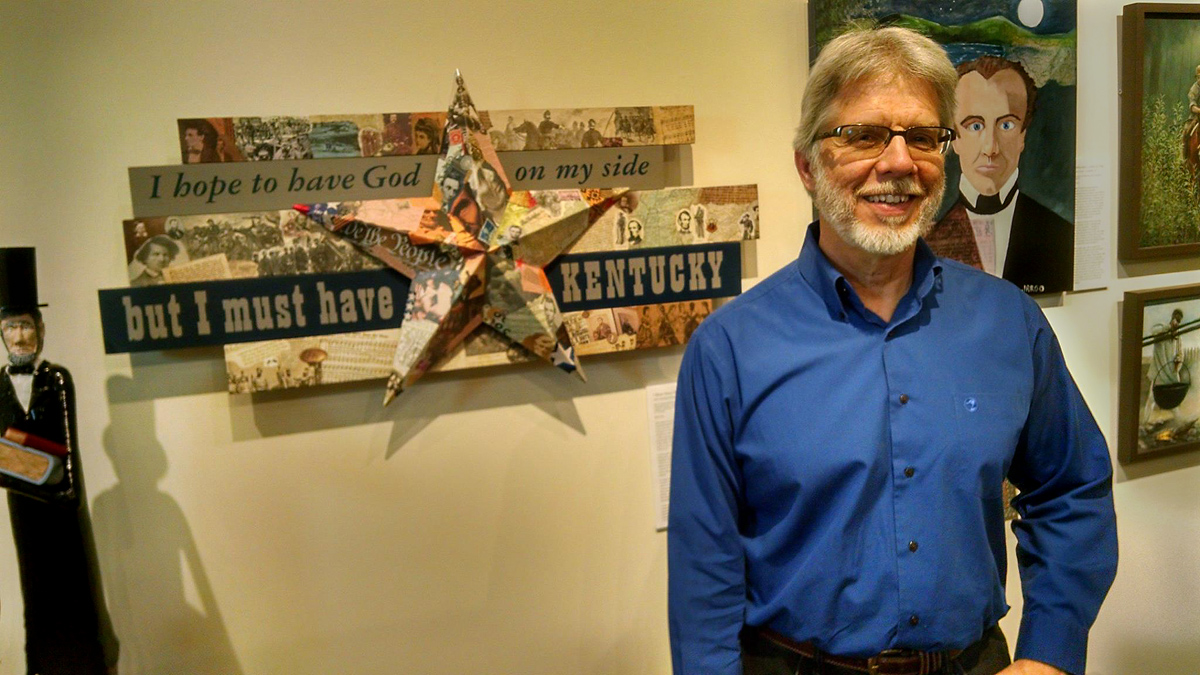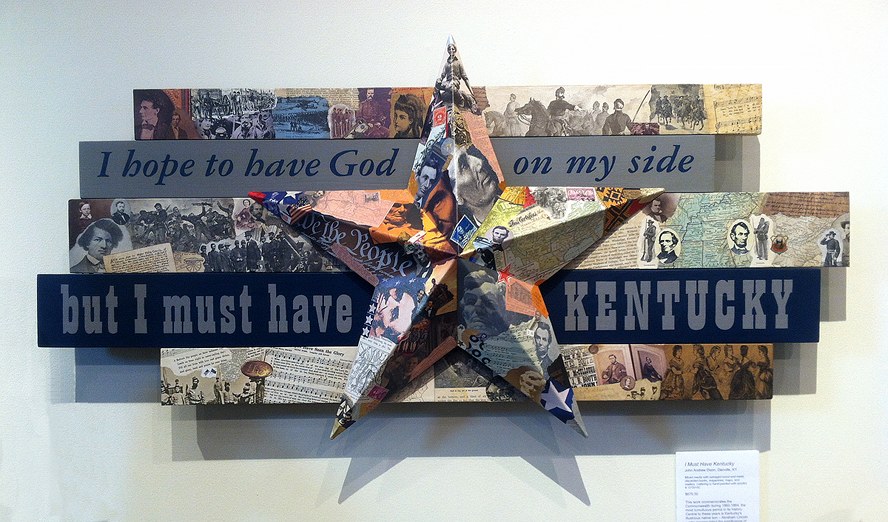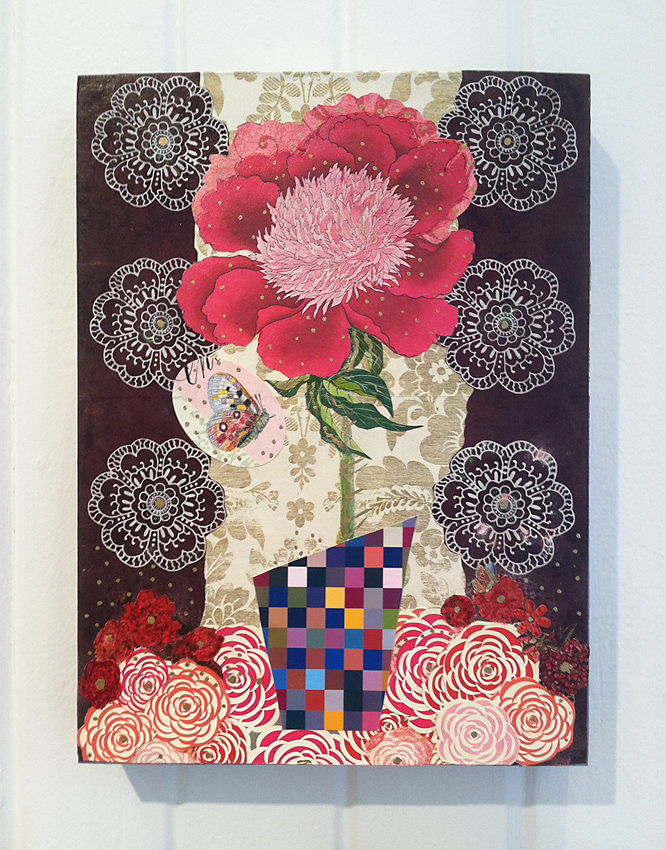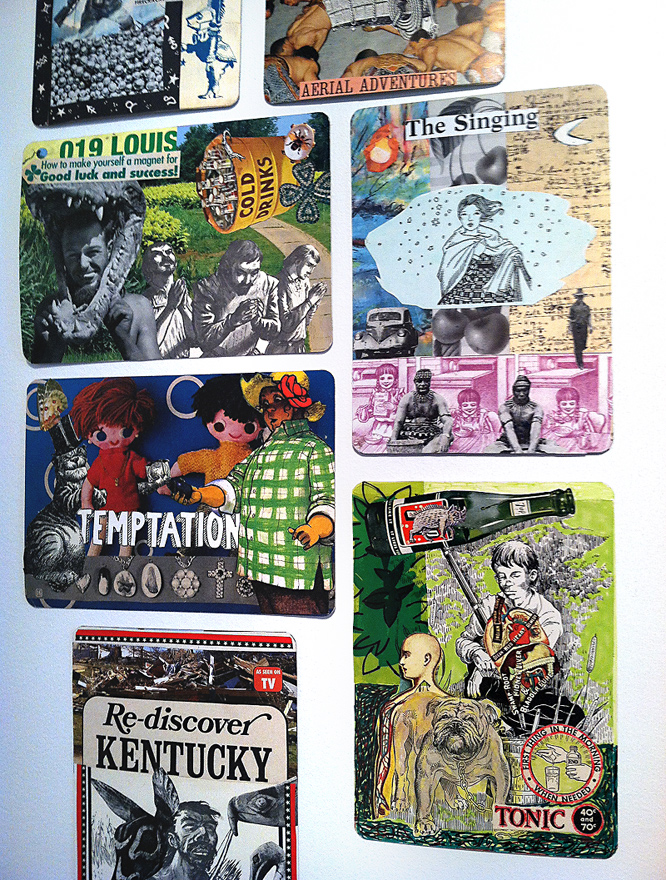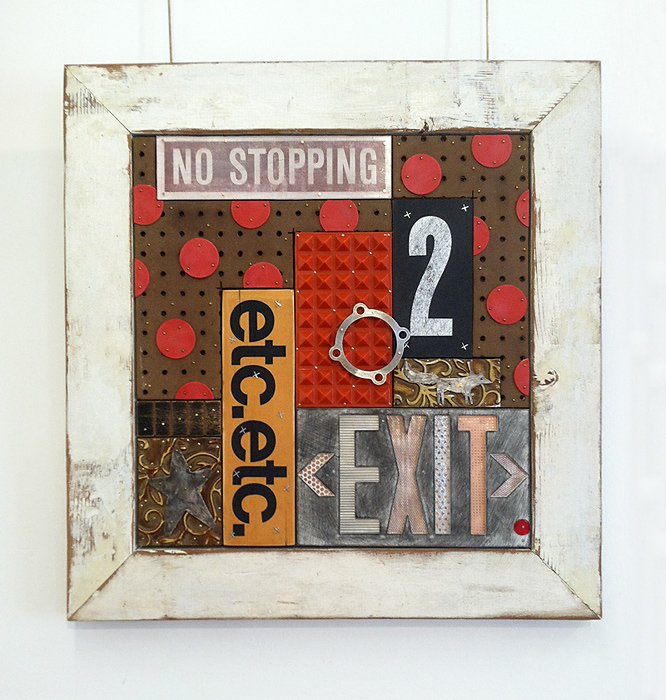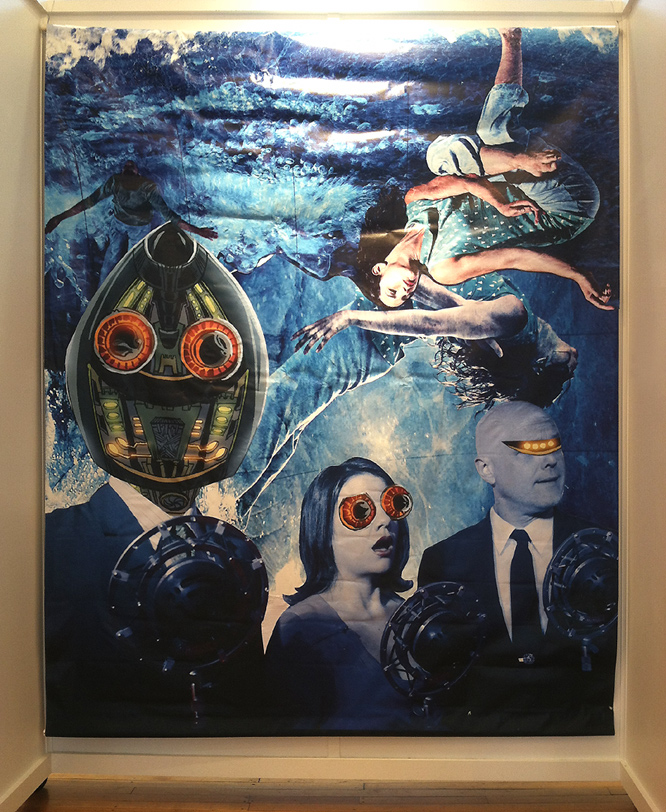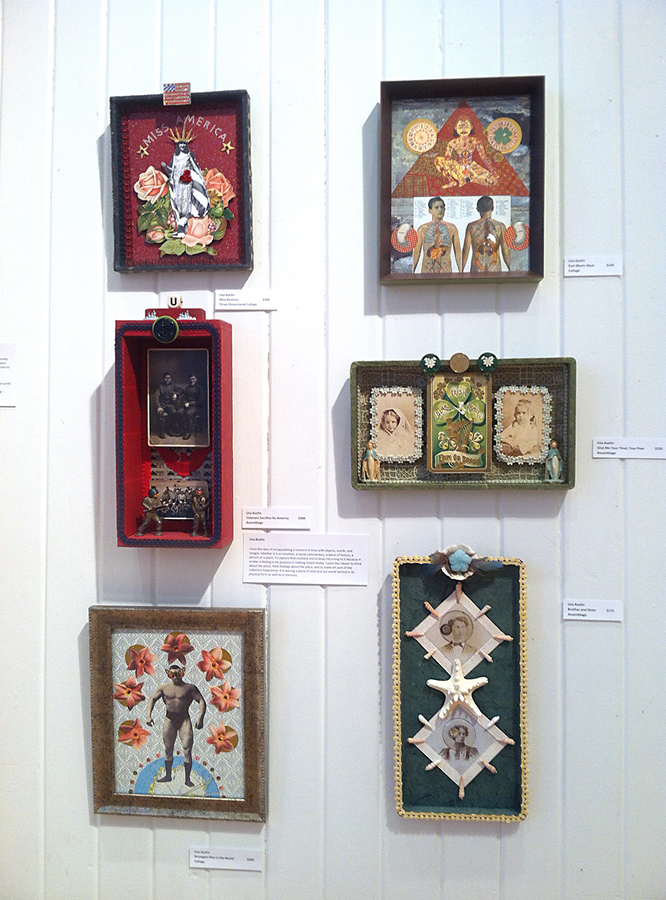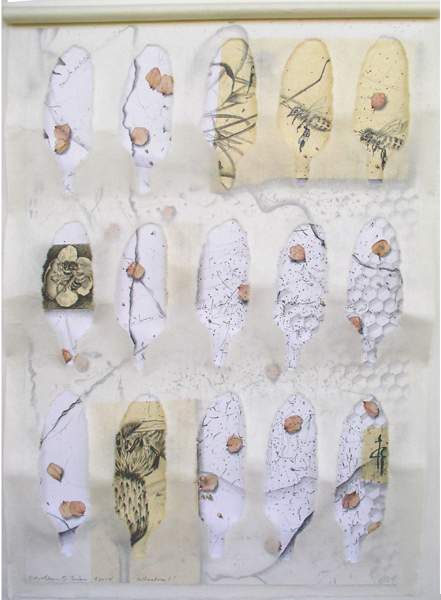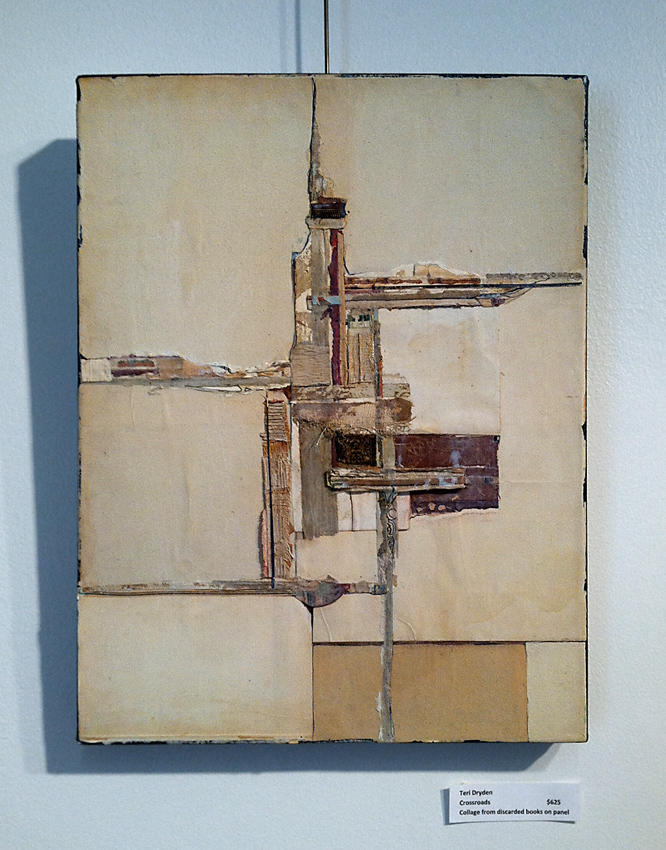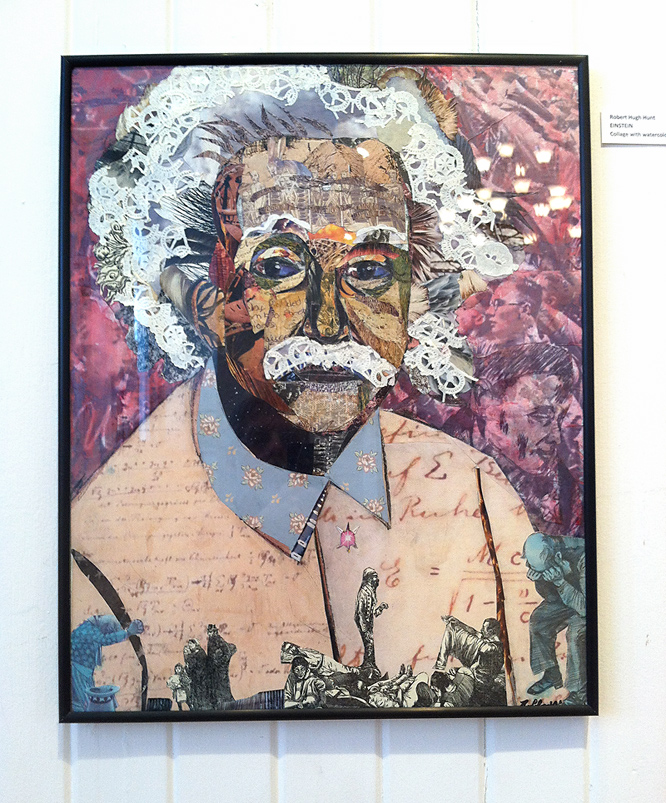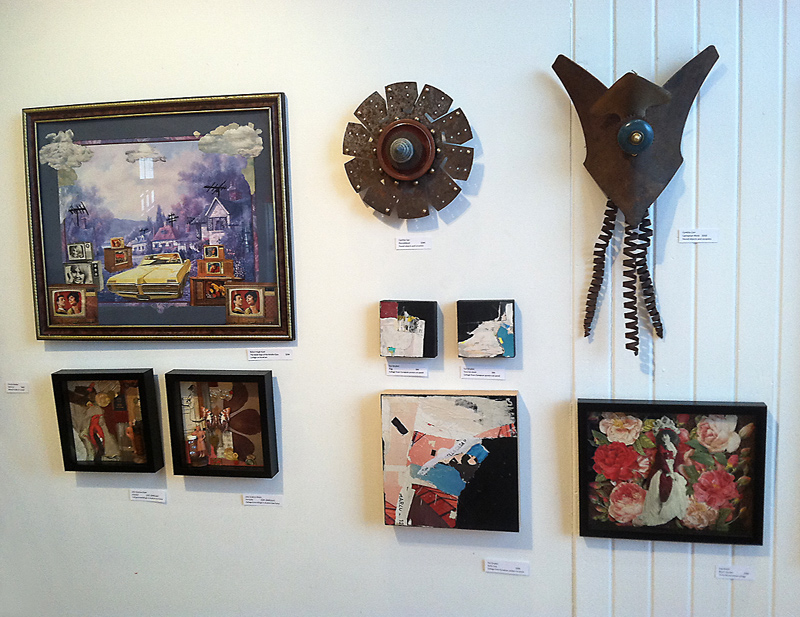Reconciliation
collage / assemblage by J A Dixon
(paper, wood, metal, postcard, packaging, tea bag)
6.875 x 8.875 inches
available for purchase
Archive for the ‘Assemblage’ Category
Reconciliation
Wednesday, December 28th, 2022March Ex(plosion) | Twentieth Collage
Saturday, March 20th, 2021Schwitters’ Army Mobilized in Rural Scotland
Monday, January 20th, 2020“. . .this is what we do in the collage community: we engage, we exchange, we manifest with one another. We emerge into a new state of being together. That is what makes art powerful. It connects us and takes us into the future.”
— Ric Kasini Kadour
Any collage artist who maintains even a casual curiosity about the legacy of Kurt Schwitters has to be enthusiastic about developments in Sanquhar. As someone who employs this space to exalt the “Master of Merz” without apology, I now feel compelled to praise Ric Kasini Kadour and his worldwide call to built a Schwitters’ Army collection of collage artwork at the center for learning established by David Rushton in the Scots town. Needless to say to an audience that visits this site with an interest in all things collage, Ric has made an impressive effort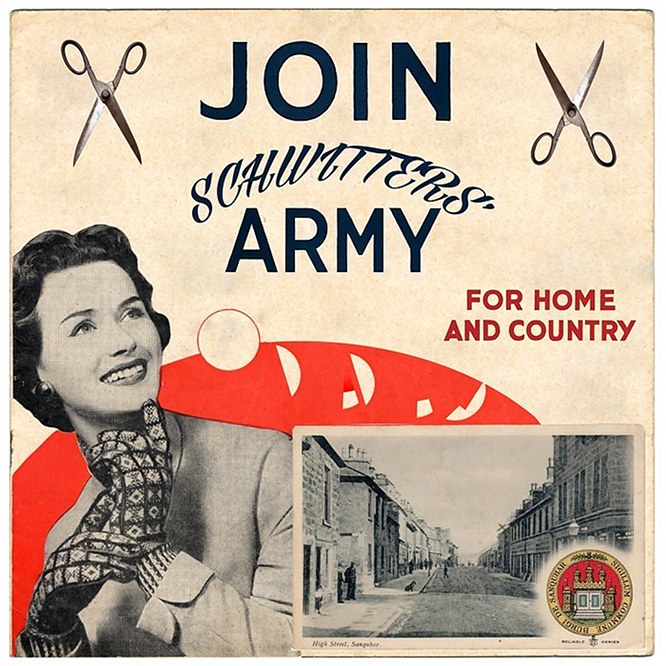 over the past few years to raise the level of discourse about a medium to which so many of us have dedicated ourselves. From Kolaj Magazine to Kolaj Institute to Kolaj Fest, he’s been making his mark for some time and clearly doesn’t intend to rest on his laurels.
over the past few years to raise the level of discourse about a medium to which so many of us have dedicated ourselves. From Kolaj Magazine to Kolaj Institute to Kolaj Fest, he’s been making his mark for some time and clearly doesn’t intend to rest on his laurels.
As part of his curatorial efforts at MERZ Gallery, he has asked contributing collage artists to answer a few questions. As I prepare to ship my donation to the cause, I’ll publish my supporting remarks here for your potential interest.
Next time: a look at the artwork and my thoughts about the context of its creation.
What is your origin story? When did you first start making collage seriously?
The first collage art that I remember creating was in the 4th or 5th grade, probably in 1961 or 1962, when I used sample chips of color from a paint store to cut and paste a mosaic-like image that won the “Poppy Day” poster contest. It’s always stood out in my memory. I thought of myself as an artist from that point forward. Nevertheless, up into high school, I would feel the lack of any competent art instruction as a keen deprivation. I convinced my parents in 1967 to enroll me as a charter student in the home-study course co-founded by Norman Rockwell called “The Famous Artists Course for Talented Young People.” Unlike the successful version for adults on which it was patterned, the package of guided assignments for teens would fail in the marketplace, but not before exposing me to a diversity of fine and applied art mediums, including collage.
Who was the first collage artist you connected with?
The Famous Artists Course would bring to my awareness many influences in the area of collage and assemblage, including Fred Otnes, Robert Rauschenberg, Louise Nevelson, Joseph Cornell, and Kurt Schwitters. Although I didn’t understand his technical methods, I initially attached my affection to the visually comprehensible Otnes, and I’d emulate his montage approach throughout my years as a professional illustrator and designer. In contrast, a series of breakthroughs in my journey to unravel the Merz of Schwitters would take another forty years, culminating in my first solo exhibition as a collage artist in 2007.
How do you connect with the collage community?
I began writing about collage and showcasing my practice at “The Collage Miniaturist” in 2012. Since then, beginning with fellow artists in Kentucky who work in the medium, I’ve collaborated with a body of dedicated collage artists. I’ve also regularly entered pieces in national and international calls for collage and submitted my work to landmark exhibitions and permanent collections. Believing that cross-pollination in collage through worldwide virtual communities is a vital force in the so-called “Post-Centennial” collage movement, I follow hundreds of active collage artists through social networks. As much as possible for someone who continues to sustain an ongoing studio and exhibition schedule, I regularly comment on trending topics and answer questions in the digital realm.
Governor’s Derby Exhibit, 2018
Thursday, May 17th, 2018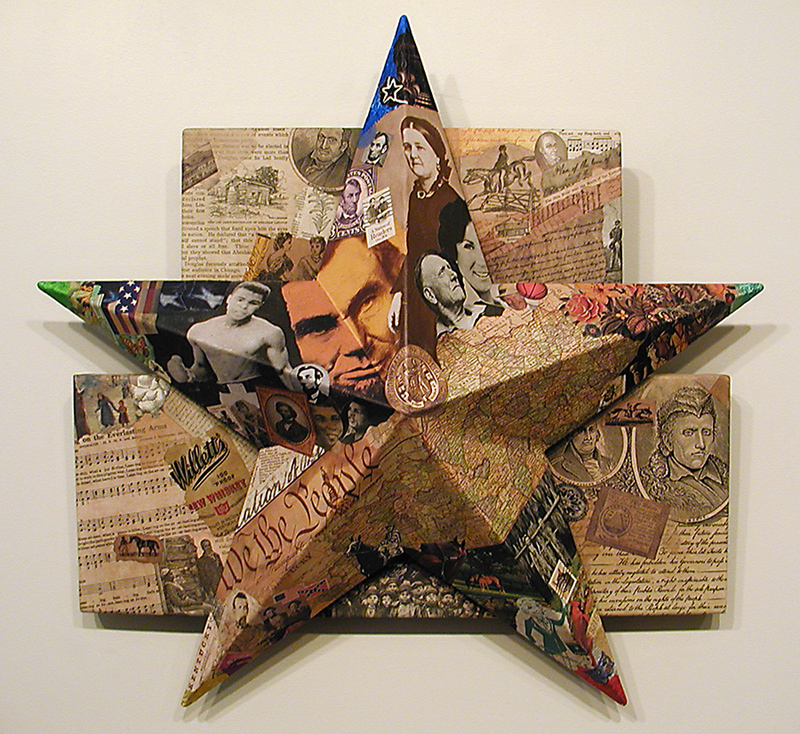 My 3D collage from last summer, Star of Commonwealth, is currently on display as part of the Governor’s Derby Exhibit titled Reflections of the Commonwealth. It is an honor to have my artwork chosen and, reportedly, positioned near the door to the Governor’s offices. Yes, it’s a cool thing, if I do say so myself. The Kentucky-themed piece was created as part of the 225th birthday celebration for our Bluegrass State. I have yet to replenish my stash (hint, hint, wink, wink) that would enable me to do another similar artwork. The annual initiative coordinated by the Kentucky Arts Council is on view in Frankfort at the Capitol Rotunda through June 4th.
My 3D collage from last summer, Star of Commonwealth, is currently on display as part of the Governor’s Derby Exhibit titled Reflections of the Commonwealth. It is an honor to have my artwork chosen and, reportedly, positioned near the door to the Governor’s offices. Yes, it’s a cool thing, if I do say so myself. The Kentucky-themed piece was created as part of the 225th birthday celebration for our Bluegrass State. I have yet to replenish my stash (hint, hint, wink, wink) that would enable me to do another similar artwork. The annual initiative coordinated by the Kentucky Arts Council is on view in Frankfort at the Capitol Rotunda through June 4th.
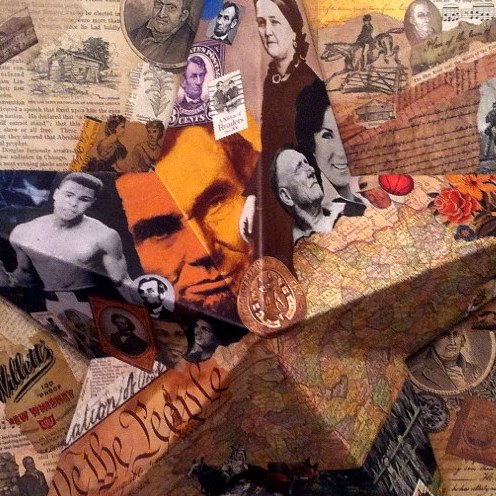
Star of Commonwealth (detail)
mixed-media collage construction by J A Dixon
22 x 21 x 6 inches
available for purchase
Top collage artists I never even knew about !!!
Saturday, January 13th, 2018“I have always tried to exploit the photograph. I use it like color, or as the poet uses the word.”
— Hannah Höch
It is always a temptation for a so-called blogger to dangle a “best of” or “top twenty” list to entice a visitor, and, of course, we see this tactic used almost on a daily basis in various fields of art and entertainment. How many of us have gone online and swallowed just such a colorful lure? On the most obvious level, the whole stimulus-response thing is a bit silly, but the potential to learn something new does exist, or to sharpen our own sense of quality, preference, and discernment. Each of us is free to have viewpoints, as long as we recognize them as personal opinions, and avoid casting them about as certitude. Isn’t there enough of that going on these days? (Yes, dear guest, that is merely my perspective.) 
What does this have to do with collage? Well, I just paid a visit to a page at AnotherMag.com (in response to the aforesaid bait), and I learned for the first time about three collage artists who were new to me, a working artist who purports to ruminate on “all things collage.” In this particular case, there may have been an explicit effort to achieve an overdue gender balance for a post intended to spotlight the Höch retrospective at the Whitechapel Gallery in London, but one could question the absence of Paolozzi, Rauschenberg, Johnson, Hamilton, or Kolář. To not include at least one of these men as a key figure in the history of collage brings no meaningful discredit on any of the artists, but only on the list. (And that, too, is just my opinion).
Nevertheless, I am not ashamed to accentuate the gaps in my collage literacy and to feature three noteworthy female artists: Eileen Agar, Nancy Spero, and Annegret Soltau. Examples of their work should have appeared here long before now.
Woman reading
by Eileen Agar, 1936
Museum of New Zealand
Protagonists
by Nancy Spero, 1989
disposition unknown
Grima – mit Katze
by Annegret Soltau, from her 1986-97 series
Vero Group Collection, Houston, Texas
Year Five: a new “Janus Project” in the works?
Tuesday, December 26th, 2017“There are, it seems, two muses: the Muse of Inspiration, who gives us inarticulate visions and desires, and the Muse of Realization, who returns again and again to say ‘It is yet more difficult than you thought.’ This is the muse of form. It may be then that form serves us best when it works as an obstruction, to baffle us and deflect our intended course. It may be that when we no longer know what to do, we have come to our real work and when we no longer know which way to go, we have begun our real journey. The mind that is not baffled is not employed. The impeded stream is the one that sings.”
― Wendell Berry
Someone once opined that “since most people feel that the world gets worse, not better, the only basis of genuinely popular art is nostalgia.” There may be some truth in that. However, one could recall examples of entirely new things gaining wide popularity, too, especially in music. The visual artist must accept that most people will never grant them the position that they ascribe to musical and culinary artists, because nothing in life will supplant music and food in their daily routine of emotional attachments (although, with the current explosion of binge-on-demand streaming entertainment, other creatives may be poised to achieve a similar status).
When I reflect on my fifth year of musing about collage at this blogsite and look ahead to the next, I realize just how much work there is in front of me to puzzle through some of these ideas.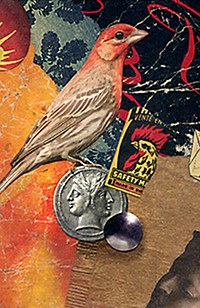 Like many artists, I hope to juggle goals that may at first seem in contradiction: to attract patrons, to inspire colleagues, and to please myself. I don’t see any way to approach it other than to balance elements of our past (the appeal of the nostalgic), our present (the lure of the trend), and our future (the surprise of the new). How convenient that balancing elements in Janus-like fashion just happens to be my craft!
Like many artists, I hope to juggle goals that may at first seem in contradiction: to attract patrons, to inspire colleagues, and to please myself. I don’t see any way to approach it other than to balance elements of our past (the appeal of the nostalgic), our present (the lure of the trend), and our future (the surprise of the new). How convenient that balancing elements in Janus-like fashion just happens to be my craft!
In all seriousness, collage (and the related montage-inherent media) are almost uniquely suited to the challenge at hand, and perhaps that is why post-centennial collage is becoming a worldwide phenomenon in the 21st. Diving more deeply into this quandary will provide ample food for thought in the coming year. Meanwhile, I shall make more!
Nikki Soppelsa
Look ahead to a discussion of “ultra miniaturism” in collage.
Robert Hugh Hunt
Stay tuned for a review of contemporary collage abstraction.
Terry R Flowers
Is it time to peruse the long history of humor in collage?
Kurt Schwitters
And I shall never tire of studying and sharing the work of KS.
Star of Commonwealth
Wednesday, July 26th, 2017“I have to trust for that crazy moment.”
— Christoph Niemann
It is no secret that creative work has not been flying off the walls in the current art market, but there is something about the theme of 225: Artists Celebrate Kentucky’s History, hanging this summer in the Kentucky Artisan Center at Berea, that has provoked an unusual number of sales, including the mixed media construction that I titled I Must Have Kentucky and featured here in March. The kind folks at the Center asked me to deliver a replacement piece sight unseen. Sounded good — but the first work had made a serious dent in my stash of Kentucky-related scrap. I’ll admit that I scratched my head about what I could come up with. Fortunately, I had a second salvaged metal star that enabled me to utterly obliterate what was left of my repository of images with any connection to the Bluegrass State, including material from discarded books, hymnals, maps, magazines, product labels, and postage stamps.
I began with a goal of contrasting a simple dimensional configuration with a density of images and symbolic messages, but I was a bit dubious about where it would lead me. I recall the distinct turning point when I took comfort in the thought, “This is starting to look good. This just might work out.” How can one go wrong with images of Kentucky’s towering native sons? Her historical presence will always be linked to Abraham Lincoln (perhaps America’s greatest president, and who has come to represent much more to the world), as well as Louisville’s Muhammad Ali (perhaps America’s greatest athlete, and who also has come to represent much more to the world). Either, or both, can be called “The Greatest.” Can any other state match that? Other individuals featured in the work are Lincoln’s first lady, Mary Todd — plus Daniel Boone, Simon Kenton, Loretta Lynn, Robert Penn Warren, Ephraim McDowell, Ned Beatty, Frederick Douglass, George Rogers Clark, and Jefferson Davis. The viewer will also find visual references to faith, sport, thoroughbreds, whiskey, coal, tobacco, the U.S. Constitution, and the Civil War, with an institution central to the bitter national conflict: slavery. I am pleased with how the companion to its larger half-brother turned out. Perhaps it also will find a home, and then I can assign myself to replenishing my Kentucky file. The show lasts until September 23rd.
As I’ve probably told you before, I enjoy creating works that have visual appeal from across a room, but also provide a depth of interest on close observation, with stimulating details at an intimate viewing distance. A future entry will zoom in for another one of our nosey examinations.

Star of Commonwealth
mixed-media collage construction by J A Dixon
22 x 21 x 6 inches
available for purchase
I Must Have Kentucky ~ all the details
Sunday, April 2nd, 2017“I think to lose Kentucky is nearly the same as to lose the whole game. Kentucky gone, we cannot hold Missouri, nor Maryland. These all against us, and the job on our hands is too large for us. We would as well consent to separation at once, including the surrender of this capitol.”
— Abraham Lincoln, 1861
I am constantly experimenting, because I find it difficult to pluck a coherent idea from a “cold start,” and so I cultivate a habit of collage experimentation to preserve a state of receptivity and to invite the uncanny “synchronicities” from which a more rational concept can be refined. More often than not, there are no distinct memories associated with the genesis of an idea. It is unusual, therefore, to have a clear recollection of the creative lineage for I Must Have Kentucky, currently on display as part of 225: Artists Celebrate Kentucky’s History.
I was stumped about how to respond when a call to artists from curator Gwen Heffner announced an exhibition to observe Kentucky’s 225th birthday. I thought about the history of my own town (Danville, the first capital of the state), about the The Kentucky Documentary Photographic Project, about the story of tobacco growing families in Kentucky, and about the great Kentucky abolitionists. There were so many fascinating subjects, but none of them sparked a visual flame in my imagination. When I shared my befuddlement with Dana, my “partner in all things,” she suggested I consider doing something with Star of Abraham, an artifact I made in 2009 for the bicentennial of the 16th president’s birth. 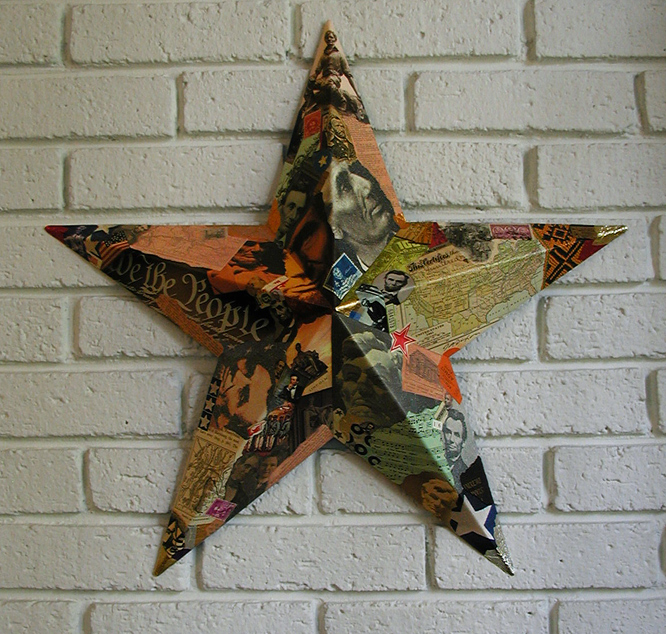 The bulk of my collected Lincoln images had been exploited to cover a salvaged metal star. To produce a collage tribute to the martyred leader with a folk-art quality seemed a technique appropriate to the occasion, and it was still in my studio, generating little interest from visitors. I liked the notion of using it as a “found object” in a larger assemblage, but there needed to be more to it than that. The solution finally hit me on a drive to our family farm, when I turned off the radio and focused on the rolling “knobs” that surrounded me: Lincoln’s famous declaration about his home state during the Civil War!
The bulk of my collected Lincoln images had been exploited to cover a salvaged metal star. To produce a collage tribute to the martyred leader with a folk-art quality seemed a technique appropriate to the occasion, and it was still in my studio, generating little interest from visitors. I liked the notion of using it as a “found object” in a larger assemblage, but there needed to be more to it than that. The solution finally hit me on a drive to our family farm, when I turned off the radio and focused on the rolling “knobs” that surrounded me: Lincoln’s famous declaration about his home state during the Civil War!
I got down a flurry of thumbnail concepts in my journal when I arrived at my destination. It was barely necessary to ever look at them again, because the development toward a final idea took on a momentum of its own. I realized I could enlarge my Lincoln theme with additional artisanship to include the importance of Kentucky in his strategic thinking. A design took shape in my sketches, and I searched my stash for images that would do justice to the “brother against brother, family against family” character of the conflict in a state that gave birth to the presidents of each warring side.
The expanded mixed-media construction is created from recycled materials — found ingredients include salvaged wood and metal, plus discarded books, magazines, maps, and mailed promotions. My lettering is hand painted with acrylics. 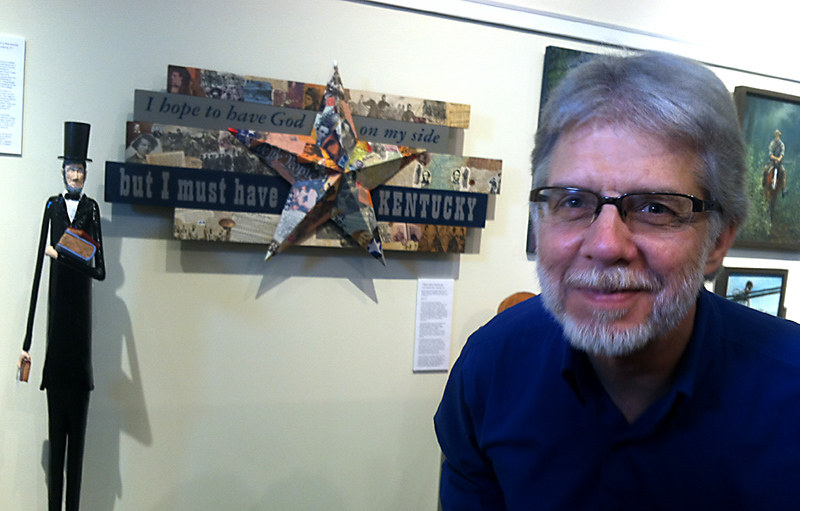 Obviously, the dimensional star represents Abraham Lincoln. The five horizontal bands signify the final years of his life and the impact his decisions had on Kentucky and the United States during that time. Among the individuals featured are Kentucky native Jefferson Davis, Lincoln’s rival in war, and Senator Stephen A. Douglas, his rival in peace, plus Lexington native Mary Todd, her sons Willie and Robert, Munfordville native Simon B. Buckner, Frederick Douglass, U.S. Grant, Clara Barton, John Hunt Morgan, and others. Also represented: soldiers, their ladies, Kentucky coal miners, and the decisive Battle of Perryville.
Obviously, the dimensional star represents Abraham Lincoln. The five horizontal bands signify the final years of his life and the impact his decisions had on Kentucky and the United States during that time. Among the individuals featured are Kentucky native Jefferson Davis, Lincoln’s rival in war, and Senator Stephen A. Douglas, his rival in peace, plus Lexington native Mary Todd, her sons Willie and Robert, Munfordville native Simon B. Buckner, Frederick Douglass, U.S. Grant, Clara Barton, John Hunt Morgan, and others. Also represented: soldiers, their ladies, Kentucky coal miners, and the decisive Battle of Perryville.
The artwork commemorates our Commonwealth during 1860 to 1864, the most tumultuous period in its history. At the center of those pivotal years is the towering figure of its most illustrious native son, who encapsulated the significance of the border state to the cause of national unity when he reputedly declared:
“I hope to have God on my side, but I must have Kentucky”.
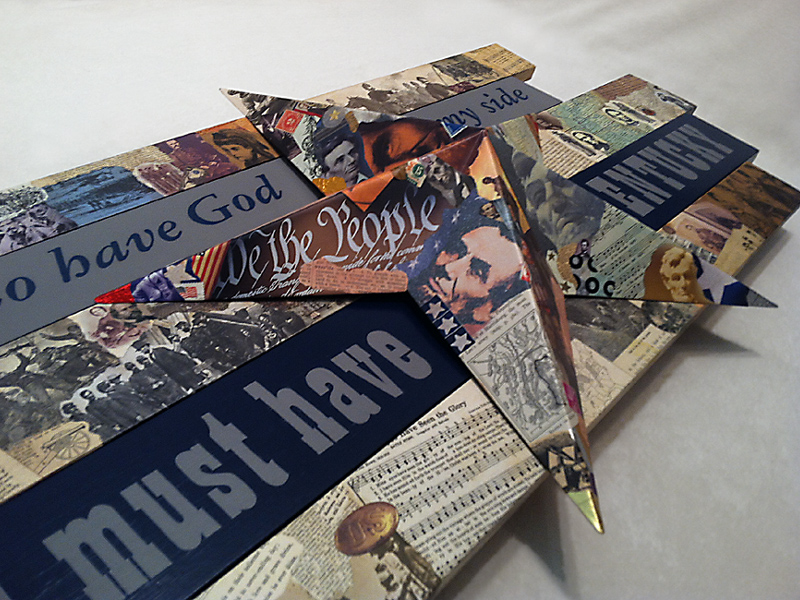
I secured the existing ‘Star of Abraham’ to a construction of five salvaged
wood planks, which alternates hand-painted lettering with my typical collage
treatment. My Lincoln artifact had finally found a fitting context.
I long have found interesting that Kentucky had given birth to both
presidential leaders in the national conflict, and I devoted a section of my
composition to that inexplicable fact.
Border-state Kentuckians were divided when war broke out. Munfordville
native Simon B. Buckner attempted to enforce its neutrality before accepting
a Confederate commission. He led troops at the strategic Battle of Perryville
in 1862, and later became a scandal-plagued governor of the Commonwealth.
One of my favorite spots in the piece: Lincoln’s boy Willie, U.S. Grant, a young
Frederick Douglass as a free man next to a slaveholder’s advertisement,
a superb wood engraving of combat, Clara Barton, Samuel Colt, and an image
of the Commander in Chief that indicates his unusual height.
Thanks for reading such a long entry. I invite you to register and comment here. Let me know what you think. If anything bugs you, constructive criticism is encouraged!
I Must Have Kentucky
Sunday, March 26th, 2017There is a new exhibition by the Kentucky Artisan Center at Berea — 225: Artists Celebrate Kentucky’s History — and I am proud to have my work as part of the display.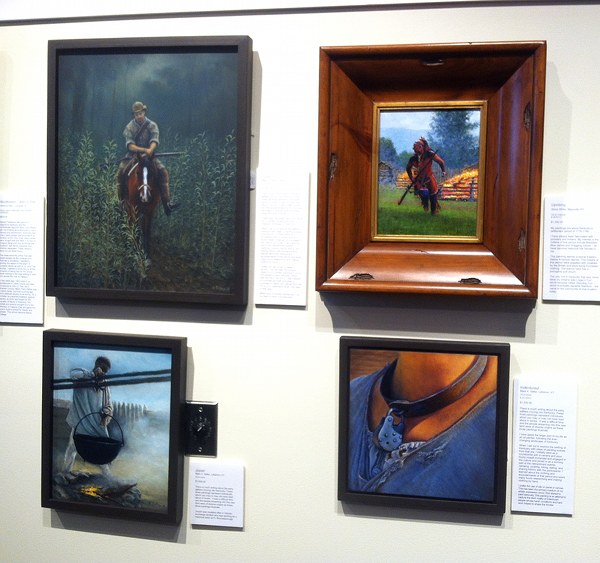
My friend and fellow exhibitor Kathleen O’Brien wrote a fine account of the opening reception at her studio blog. She was kind enough to include some information about me.
From the KACB notice: “Kentucky has always cherished its history. The preservation of Kentucky stories, places and traditions has shaped its culture today. This exhibit includes over 60 works by 51 Kentucky artists who have recorded and celebrated numerous facets of Kentucky’s rich 225-year history. These works capture the essence of Kentucky — including its historical places, people, events, state commerce, agriculture and the state’s unique flora and fauna. Accompanied by written stories and histories in each artist’s words, this exhibit entices the viewer visually and verbally.” The show lasts until September 23, 2017.
My next entry will look a bit more closely at the work and its creation.
I Must Have Kentucky
mixed-media collage construction by J A Dixon
42.75 x 20.5 inches
• S O L D
a final glance back at JUXTAPOSE . . .
Tuesday, May 3rd, 2016“Collage artists form a unique and interesting community. The hunt for found materials is crucial to the process of many collage artists, causing them to be consummate collectors of things. Their collecting of material artifacts for their artistic appeal and possibilities, rather than for rarity or value, often makes them keenly aware of popular culture — present and past — with the subtle eye of an anthropological curator.”
— Cecil Touchon
During a gallery talk in early March for JUXTAPOSE, I floated this question to my audience: “What makes collage and assemblage rewarding for those of us who can draw?” The answer for me is that we see in the found material of our physical surroundings the ingredients for a different kind of creative spontaneity. As in most improvisational activity, there is a splendid opportunity for mystery, surprise, discovery, and joy. But there is more to it than that. I am convinced that what distinguishes artists who do contemporary collage and assemblage is their acute connection to the mundane “stuff” of culture and the inner need to bring a measure of order and harmony from the sheer volume of material produced by our throw-away society — with its chaotic, numbing effect on our sensibilities — to infuse a new energy into that which would otherwise be discarded. It is a burning desire to create value when none exists and to find wonder, meaning, significance, and (yes) beauty, where none could have been expected.
It was a distinct privilege to exhibit with some of the finest collage and assemblage artists in Kentucky, and if nothing else happens on the art front for the balance of 2016, JUXTAPOSE will have made my year.
Pretty Please Peony
Meg Higgins
collage on wood panel
collaborative collage on oversized playing cards
Robert H Hunt and Terry R Flowers
No Stopping
Brad Devlin
assemblage, found objects
Intergalactic Passion
Brandon Long
recycled promotional banners
six collage/assemblage artworks
Lisa Austin
Pollinators 1
Kathleen O’Brien
mixed-media collage
Crossroads
Teri Dryden
collage from discarded books on panel
Einstein
Robert Hugh Hunt
collage with watercolor on canvas board
This image represents to me the strong diversity of the JUXTAPOSE exhibition and reminds me of the exceptional “company” my art shared earlier this year — a pair of shadow boxes by yours truly in proximity to pieces by Robert Hugh Hunt, Cynthia Carr, Teri Dryden, and Lisa Austin.
It won’t surprise you to learn that I am looking for a good excuse to publish a compilation of JUXTAPOSE images with artist comments. Please let me know if that interests you!
